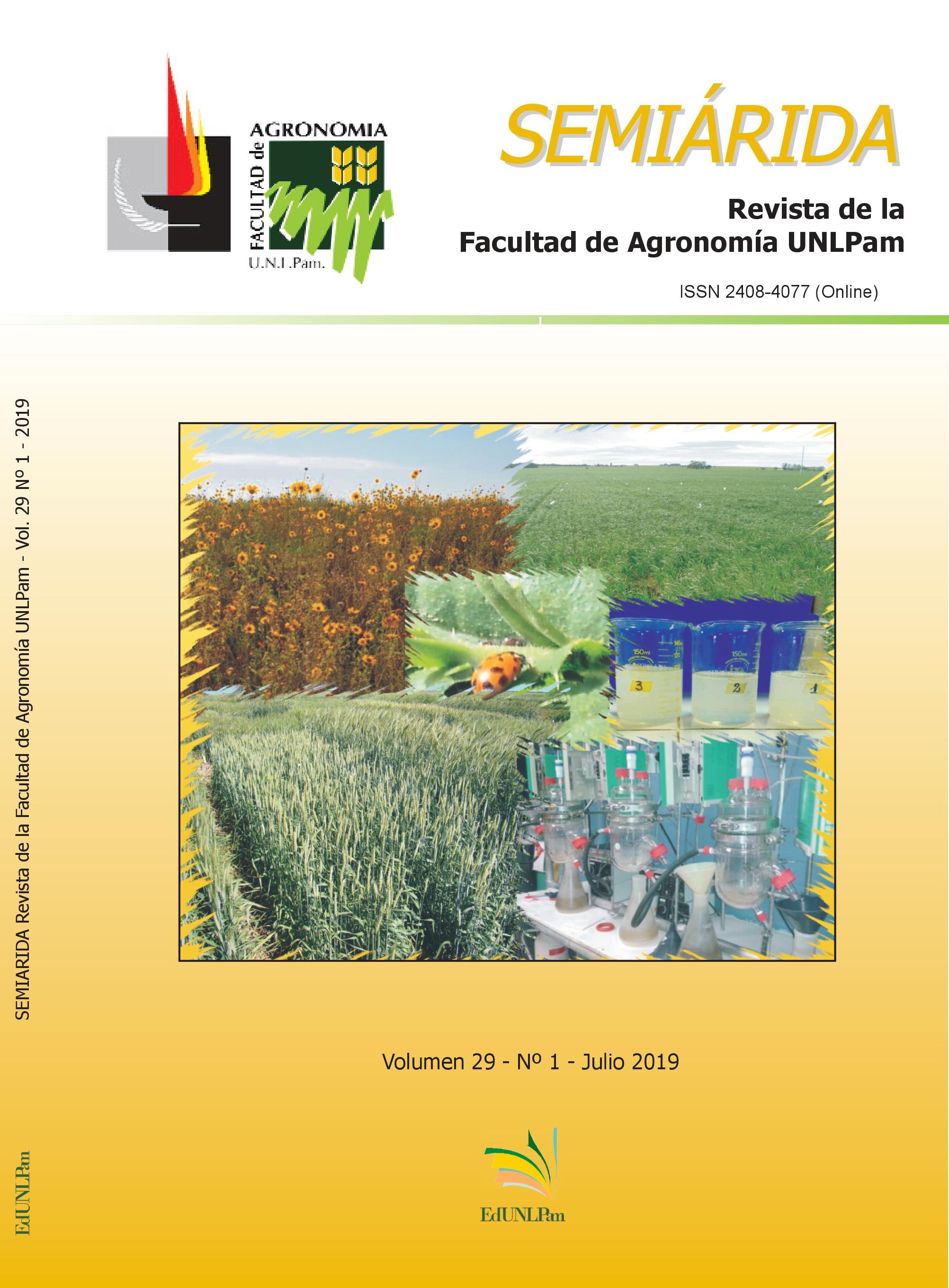Influence of planting date on yield components in safflower crop (Carthamus tinctorius L.) in La Pampa
DOI:
https://doi.org/10.19137/semiarida.2019(01).63-69Keywords:
safflower, sowing dates, yield, insects,Abstract
The sowing date of the safflower crop varies according to the area and is one of the most important factors in production. The main objective of the work was to establish an optimal planting season to reduce the days elapsed between sowing, germination and emergence, thus decreasing plant losses due to greater exposure to diseases, insects and herbivorous animals, without compromising the components of yield for a time of inadequate planting. The second objective was to expand the information on the harmful insect species as well as the beneficial ones. The study was a with three replications, treatments were Regarding the possible sowing dates in the semiarid Pampas region, the date of mid August (08/15/2014) and mid September (09/18/2014) are those with the highest yields. The date of mid August is recommended because later dates make it more difficult to control weeds due to the conditions of higher temperature and frequently higher level of precipitation. During the crop cycle, sixteen harmful species were identified belonging to the orders: Hemiptera (9 species), Thysanoptera (1 species), Lepidoptera (3 species) and Coleoptera (3 species). As for the beneficial species, seven were found belonging to the orders: Coleoptera (3 species) Hemiptera (1 species), Hymenoptera (2 species) and Araneae (1 species).
Downloads
References
Corró Molas, A. (2010). ECR y Fechas de siembra. Gral. Pico, La Pampa. Informe campaña cártamo 2009/10.
Covas, G. (1976). Nueva variedad de Cártamo obtenida en la Estación Experimental Anguil. Informativo de Tecnología Agropecuaria para la Región Semiárida Pampeana. INTA. N°68. 8p
Dughetti, A. C., y Zárate A. O. (2011). Convenio Oleaginosas Moreno SA. EEA INTA Hilario Ascasubi. Resultados de la actividad con el cultivo de cártamo.
Giayetto, O., Fernández, E. M, Asnal, W. E, Cerioni, G. A, y Cholaky, L. (1999). Comportamiento de Cultivares de Cártamo (Carthamus tinctorius L.) en la Región de Río Cuarto, Córdoba (Argentina). Investigación agraria. Producción y protección vegetal,14(12).
InfoStat 2009. Grupo InfoStat, FCA, Universidad Nacional de Córdoba. Primera Edición.
Fritz, F. (2015). Estudio de insectos perjudiciales y benéficos en cultivo de cártamo en la región pampeana semiárida. (Trabajo Final de Graduación). Facultad de Agronomía. UNLPam.
Lang, M. 2011. El cultivo de cártamo (Carthamus tinctorius L.) en la región semiárida pampeana: ensayo comparativo de rendimiento. Revista de la Facultad de Agronomía UNLPam, 22, 32-36. https://cerac.unlpam.edu.ar/index.php/semiarida/article/view/4524/4686
Luayza, G. G., Brevedan R. E. & Palomo, I. R. (1997). Safflower production in Argentina: Central Area, IVth International Safflower Conference Proceedings, June 27 1997. Bari, Italia.
MAGyP Ministerio de Agricultura Ganadería y Pesca. 2018). (Sistema Integrado de Información Agrícola. www.minagri.gob.ar
Mirassón, H. R., Palomo, I. R., Brevedan R.E. & Fioretti, M. N. (2001). Safflower production in Argentina: Future prospects. Vth International Safflower Conference Proceedings, July 2327 (2001). Sidney, Montana , USA.
Mirassón, R. R. & Brevedan, R. E. (2002). Agronomic performance of safflower in the central semiarid región of Argentina. ASA, CSS and SSSA. Annual Meeting Proceedings. Indiana, USA.
Mirassón, H. R., Palomo, I. R., Brevedan R. E., y Fioretti, M. N. (2011). Rendimiento y estabilidad de variedades de cártamo (Carthamus tinctorius L.) en la región Pampeana Semiárida. Phyton, 80, 147-151.
Montoya Coronado, L. (2010). El cultivo del cártamo (Carthamus tinctorius L.) en México. Instituto Nacional de Investigaciones Forestales, Agrícolas y Pecuarias Progreso N° 5, Barrio de Santa Catarina Delegación Coyoacán. México D.F. 98 p.
Mündel, H. H., Blackshaw, R. E., Byers, J. R., Huang, H. C., Johnson, D. L., Keon, R., Kubik, J., Mckenzie, R., Otto, B., Coth, B., & Stanford, K. (2004). Safflower Production on the Canadian Prairies. http://safflower.wsu.edu/SafflowerProduction_Canada.pdf
Rivas, J. y Matarazzo, R. (2009). Producción de Cártamo consideraciones generales. Boletín de divulgación N° 20 Sistema Nacional Argentino de Vigilancia y Monitoreo de Plagas. www.sinavimo.gov.ar/cultivo/carthamustinctorius
Vergara, G. T. y Casagrande, G. A. (2012). Estadísticas agroclimáticas de la Facultad de Agronomía, Santa Rosa, La Pampa, Argentina 19772010. Revista de la Facultad de Agronomía UNLPam, 22 (1), 74. https://cerac.unlpam.edu.ar/index.php/semiarida/issue/view/346
Downloads
Published
Issue
Section
License
La Editorial de la Universidad Nacional de La Pampa (EdUNLPam) exigirá a los/as autores/as la firma del siguiente documento:
La EdUNLPam lleva a cabo la publicación del artículo: (Título del Artículo) en SEMIÁRIDA Rev.Fac.Agron UNLPam ISSN 2362-4337 (impresa) ISSN 2408-4077 (en línea), del cual el/los abajo firmantes son autores de una o más partes. En el mismo acto, el/los autores entregan exclusivamente a la EdUNLPam todos sus derechos protegidos por las leyes de propiedad intelectual que rigen en la Argentina para reproducir, publicar, editar, fijar, comunicar y transmitir públicamente en cualquier formato o medio impreso o electrónico, inclusive internet, el artículo enviado a publicación e incluirlo en índices o bases de datos nacionales e internacionales. A cambio, la EdUNLPam entrega a los autores la autorización para la publicación o reimpresión con ines académicos y educativos en cualquier libro o medio de divulgación, con la sola obligación de citar el artículo original publicado en la EdUNLPam. Cada autor acuerda en que el material provisto a la EdUNLPam es un trabajo original, que no ha sido impreso o publicado en cualquier otro medio con anterioridad y que no vulnera derechos de terceros. El Primer autor tendrá la posibilidad de leer y corregir el artículo ya editado como “prueba de galera”, pero si el autor no devolviera esas correcciones de la prueba de galera dentro del tiempo especificado, el proceso de producción y publicación podrá proseguir sin la aprobación del autor. El/los autor/es no recibirán compensación monetaria de la EdUNLPam por el uso del material contenido en este artículo y asumen la responsabilidad de las opiniones vertidas en él.










.png)



22.png)



.jpg)




.jpg)
